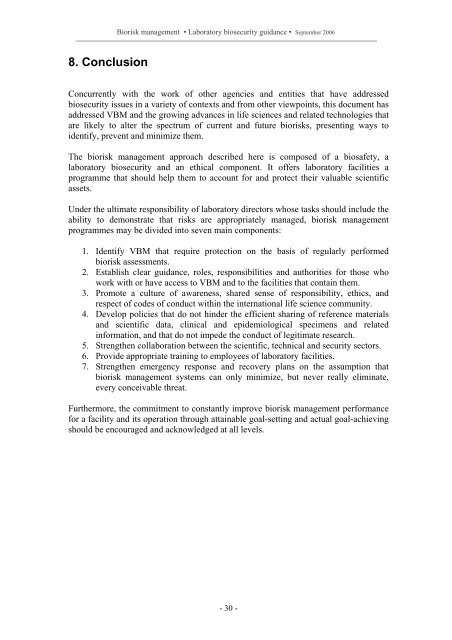Laboratory biosecurity guidance - World Health Organization
Laboratory biosecurity guidance - World Health Organization
Laboratory biosecurity guidance - World Health Organization
Create successful ePaper yourself
Turn your PDF publications into a flip-book with our unique Google optimized e-Paper software.
8. Conclusion<br />
Biorisk management • <strong>Laboratory</strong> <strong>biosecurity</strong> <strong>guidance</strong> • September 2006<br />
Concurrently with the work of other agencies and entities that have addressed<br />
<strong>biosecurity</strong> issues in a variety of contexts and from other viewpoints, this document has<br />
addressed VBM and the growing advances in life sciences and related technologies that<br />
are likely to alter the spectrum of current and future biorisks, presenting ways to<br />
identify, prevent and minimize them.<br />
The biorisk management approach described here is composed of a biosafety, a<br />
laboratory <strong>biosecurity</strong> and an ethical component. It offers laboratory facilities a<br />
programme that should help them to account for and protect their valuable scientific<br />
assets.<br />
Under the ultimate responsibility of laboratory directors whose tasks should include the<br />
ability to demonstrate that risks are appropriately managed, biorisk management<br />
programmes may be divided into seven main components:<br />
1. Identify VBM that require protection on the basis of regularly performed<br />
biorisk assessments.<br />
2. Establish clear <strong>guidance</strong>, roles, responsibilities and authorities for those who<br />
work with or have access to VBM and to the facilities that contain them.<br />
3. Promote a culture of awareness, shared sense of responsibility, ethics, and<br />
respect of codes of conduct within the international life science community.<br />
4. Develop policies that do not hinder the efficient sharing of reference materials<br />
and scientific data, clinical and epidemiological specimens and related<br />
information, and that do not impede the conduct of legitimate research.<br />
5. Strengthen collaboration between the scientific, technical and security sectors.<br />
6. Provide appropriate training to employees of laboratory facilities.<br />
7. Strengthen emergency response and recovery plans on the assumption that<br />
biorisk management systems can only minimize, but never really eliminate,<br />
every conceivable threat.<br />
Furthermore, the commitment to constantly improve biorisk management performance<br />
for a facility and its operation through attainable goal-setting and actual goal-achieving<br />
should be encouraged and acknowledged at all levels.<br />
- 30 -

















